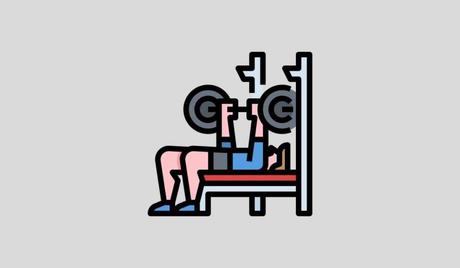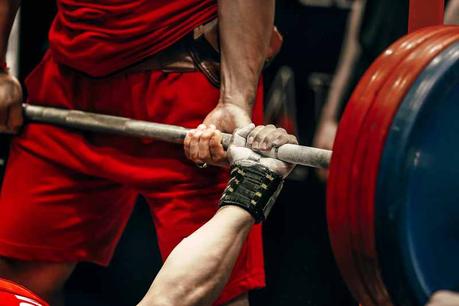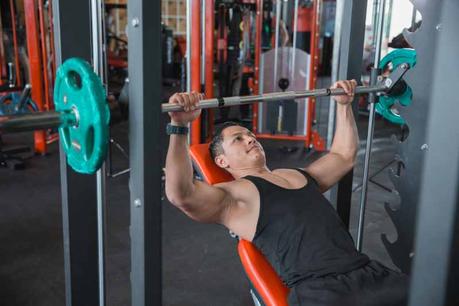Torn between using a Smith Machine or barbell for bench press? Here’s a look at the pros, cons and differences of both so that you can conquer chest day.

The Smith machine is probably one of the most under-used, under-appreciated, and under-rated machines in your gym!
While it’s not as flexible or versatile as most of the other equipment, what it does offer in terms of stability and fixed movement can actually benefit you in more ways than you realize.
I had so much fun comparing squats using a Smith machine vs squat rack that I decided to do another similar post, this time talking about using the Smith machine for bench presses and comparing it to the all-time superstar: the barbell bench press.
Get ready for a complete, in-depth look at the two exercises as I compare their pros, cons, similarities, and differences—and, of course, answer the most common questions people ask about Smith machine bench presses.
Let’s jump right in.
Barbell Bench Press – Overview
The barbell bench press—best known by the name “Olympic bench press”—is probably the single best-known weightlifting exercise ON THE PLANET.
Seriously, everyone who’s looking to get fit has probably Googled “how to improve bench press” or “how can I bench press more?” at some point.

The bench press is a test of chest, triceps, and shoulder strength, and the best recruiter of your pectoral muscles.
It’s the “superstar” for a number of reasons, chief among them:
- Maximum power recruitment. Because you’re underneath the weight, you can recruit the maximum amount of power from your chest, shoulder, and tricep muscles to push upward.
- Freedom of movement. The barbell is moving free, allowing you to find the position/form that best accommodates your joints and natural range of motion, while still engaging your secondary stabilizer muscles to keep the weight moving smoothly up and down.
Of course, it’s not without its drawbacks, the main one of which is:
- The safety risk. Because the weight is free, there is the risk that you’ll tip to one side or lose your balance. You may also find yourself stuck if you’re working with an overloaded barbell and no spotter—you just can’t get it the rest of the way up to re-rack it in its cradle, which can be seriously dangerous! And, of course, because the weight is floating free (stabilized only by your muscles), you run a real risk of incorrect posture/form that can lead to injuries (particularly in your rotator cuff and chest).
Related: 9 Reasons the Dumbbell Bench Press Kicks Butt
Smith Machine Bench Press – Overview
The Smith machine bench press takes the exact same format of exercise used for both the barbell and dumbbell bench press, but simply utilizes the fixed-track Smith machine to perform it.
There are a couple of things I love about the Smith machine bench press:
- It’s safer. Because you’ve got the Smith machine bar weight sliding up and down a track that has a lot of cradles the bar can hook onto, it’s a very safe exercise. If you’re struggling or can’t get that one last rep, you can simply rack the bar safely and end your set early, no straining or jerking, and certainly no risking crushing yourself beneath a heavy barbell.
- It’s incredibly stable. There’s no risk of tipping, falling, losing your weight, or sliding off the bench. The barbell can only move in one direction (up and down), and the track keeps your weight fully stable through the entire range of motion.
Of course, there is one BIG con that I dislike about the Smith machine bench press:
- It doesn’t allow freedom of movement. Because the barbell is sliding along a fixed plane of motion, you can’t make minute adjustments to angle and trajectory to accommodate joint issues. For example, if your elbows, wrists, or shoulders aren’t moving quite as easily as normal (due to injury or stiffness), you won’t be able to compensate.
Smith Machine Bench vs. Barbell Bench – The Differences
As you can see by the pros and cons listed above, while the two exercises are fundamentally similar (you’re lying on a bench and pressing a heavy weight upward—woopwoop!), there are a few critical differences between them.
These differences are largely why the Smith machine bench press gets so much disdain in the weightlifting community at large, and why the Olympic barbell bench press is seen as the “hero.”
See also: Bench Press vs. Push Ups: Keeping Your Chest Day Routine Fresh
I want to focus on the differences, but keep in mind that there are A LOT of times when what is “bad” for one trainee can actually be “good” for another.
Keep reading, and you’ll see what I mean.
 Difference 1: Fixed vs. Free Plane of Movement
Difference 1: Fixed vs. Free Plane of Movement

With the Smith machine bench press, there is really only one way the barbell can go when you push it: up. When you relax, the weight can only go straight down.
Because the weight is affixed to a sliding rack, the plane of movement is fixed.
As I mentioned above, this can be limiting for those who have joint problems or are recovering from an injury.
If you don’t get the placement of your bench, body, and hands JUST RIGHT, the exercise might feel weird, stiff, or awkward.
With barbell bench presses, however, you simply have to keep the weight steady/stable while pressing. Because it’s a free weight, you have greater freedom of movement, and thus you can compensate for joint and muscle insufficiencies more effectively.
TRAINER’S NOTE
While the free movement is generally better, there will be those who find the fixed plane of movement of the Smith machine is the better choice.
Specifically, beginners who haven’t yet gotten the hang of keeping the barbell stable while bench pressing.
The Smith machine is a good “starting point” for newbies who are still working on mastering the balance aspect of the barbell bench press.
 Difference 2: Muscle Isolation
Difference 2: Muscle Isolation

One of the main differences between the Smith machine bench press and the barbell bench press is muscle isolation.
When you’re bench-pressing with a barbell, your secondary stabilizer muscles are engaged in order to keep the barbell steady throughout the full range of motion. This leads to better overall functional fitness, and develops strength in more than just the muscles targeted by the bench press.
Yes, this is absolutely a good thing—but it’s not the only approach to training. Muscle isolation exercises, while not the best for overall fitness, are ideal for building real power and triggering serious size gains in specific muscles.
And that’s why so many trainees end up falling in love with Smith machine bench presses!

Because the barbell is traveling along a fixed plane of movement, there is no need for secondary stabilizer muscles to engage.
All of the focus is directly on your chest, shoulders, and triceps, with no energy “wasted” powering the muscles that help you keep your balance. Though the difference is minor, it will be noticeable after a few weeks of training.
Barbell bench presses make you a stronger person overall, but Smith machine bench presses isolate and target your chest, shoulders, and triceps to make these specific muscles stronger.
If that’s your end-goal, you’ll want to go for Smith machine over barbell bench presses.
 Difference 3: Safety
Difference 3: Safety

As I mentioned above, with a Smith machine bench press, you’re training with a much safer system than free weights.
The Smith machine features a lot of racks at various intervals that you can hook the barbell onto if you’re struggling to finish those last few reps.
Even if you don’t have a spotter, you can still train a bit heavier knowing that you’ve got a fail-safe in place should you hit muscle failure sooner than expected.
The Smith machine is also safer in terms of injury risk. There’s less of a chance the weight will tip to one side or fall backward or forward (watch these “bench press fails” videos and you’ll see what I mean), so there’s far less chance you’ll accidentally injure yourself training should you forget to lock the weights on the bar or lose your balance.
 Difference 4: Space Requirements
Difference 4: Space Requirements

This is one area where the Smith machine, unfortunately, can’t compete with the barbell. And frankly, it’s not even close.
For a barbell bench press, all you need is a flat workout bench, a barbell and some weight discs (either bumper plates or cast-iron weight plates).
Typically, you’ll need a space roughly 7 feet wide and long to accommodate the bench and the barbell.
Add in a few more square feet for a weight rack, and you’ve got the perfect makings of a home gym.
But with a Smith machine, you need a lot more free space!
You’re talking about a weight rack/machine that is easily 7 or 8 feet tall, and anywhere from 8 to 12 feet long and wide. It’s far harder to fit a Smith machine into a home gym (unless you’ve got a HUGE basement or garage) than a barbell bench press.
Smith Machine Bench vs Barbell Bench: FAQs
Is benching with a Smith machine easier?
“Easy” is a very relative term—it depends entirely on the trainee in question.
Some people with joint limitations or muscle stiffness find the free-floating barbell bench press the easier solution, while newbies struggling to master the barbell bench press form will love how easy the limitations of the Smith machine’s track make this bench press variation.
At the end of the day, whether you use the Smith machine or free weights on bench press day comes down to your specific abilities, goals, and current mobility.
Should athletes use a Smith machine for bench press?
If your goal is training for overall, more functional fitness, you’ll find the barbell is the better choice due to its recruitment of your secondary stabilizer muscles.
But if your goal is to isolate individual muscles and really train for strength, power, and size gains, working with the Smith machine for your bench press can be an effective path to seeing the results you want.
The Bottom Line
I’ve loved the Smith machine bench press since Day One—it’s a great “finishing exercise” that helps me isolate my chest muscles for those last few sets of training to failure.
Regardless of how much hate the Smith machine typically gets in the fitness community, I think it’s safe to say that it’s an excellent machine to use at the gym, provided you use it right.
I will say that the barbell bench press is the more effective choice overall, so it should be your first choice when planning your Chest Day routines.
But as you’ve seen from the information I shared above, there’s a place in your workout for Smith machine bench presses, too.
They can be exactly what you need to take your “push muscle” fitness to the next level safely and efficiently!
More Guides Like This

How to Do the Smith Machine Row Like a Champ (Plus Muscles Worked, Benefits, and More). Wondering how to do the Smith Machine row like a boss? Here’s a complete look at the benefits of this exercise, muscles used, and a step-by-step blueprint for doing it properly.
